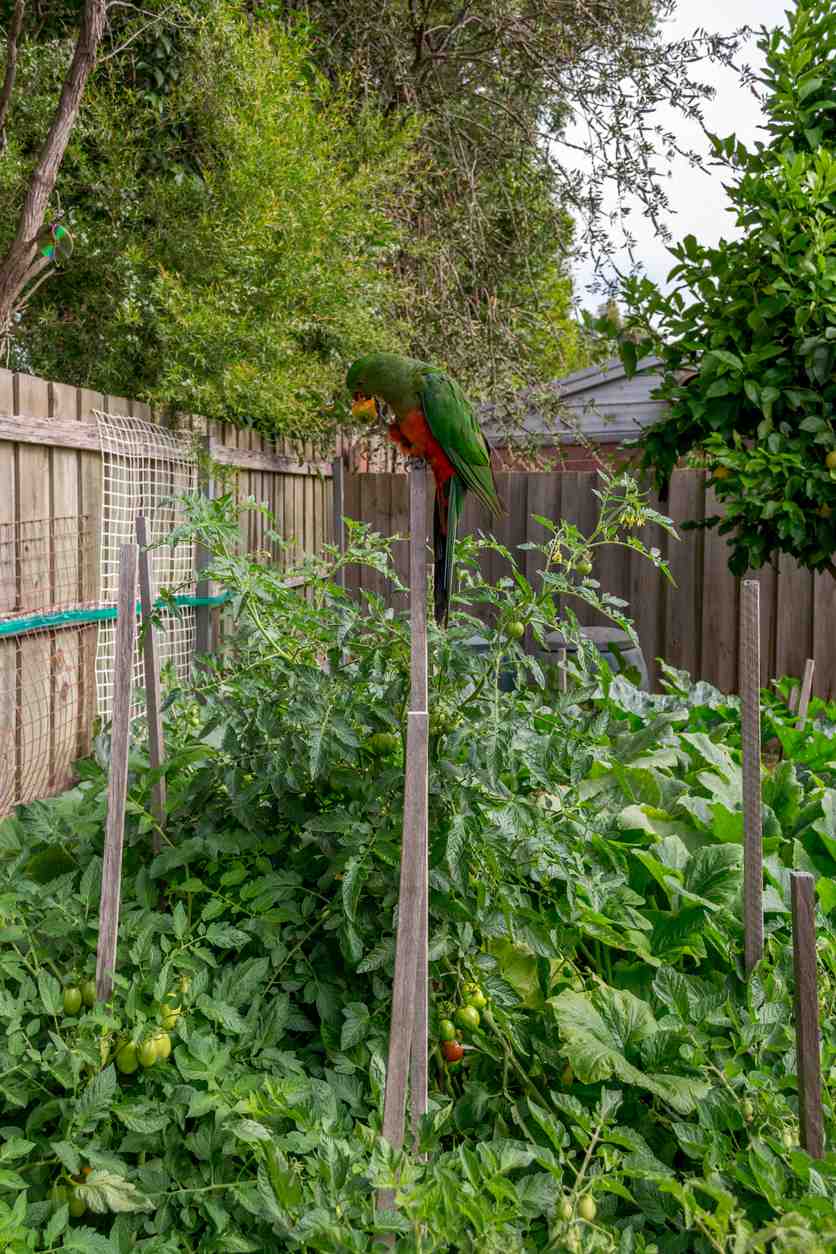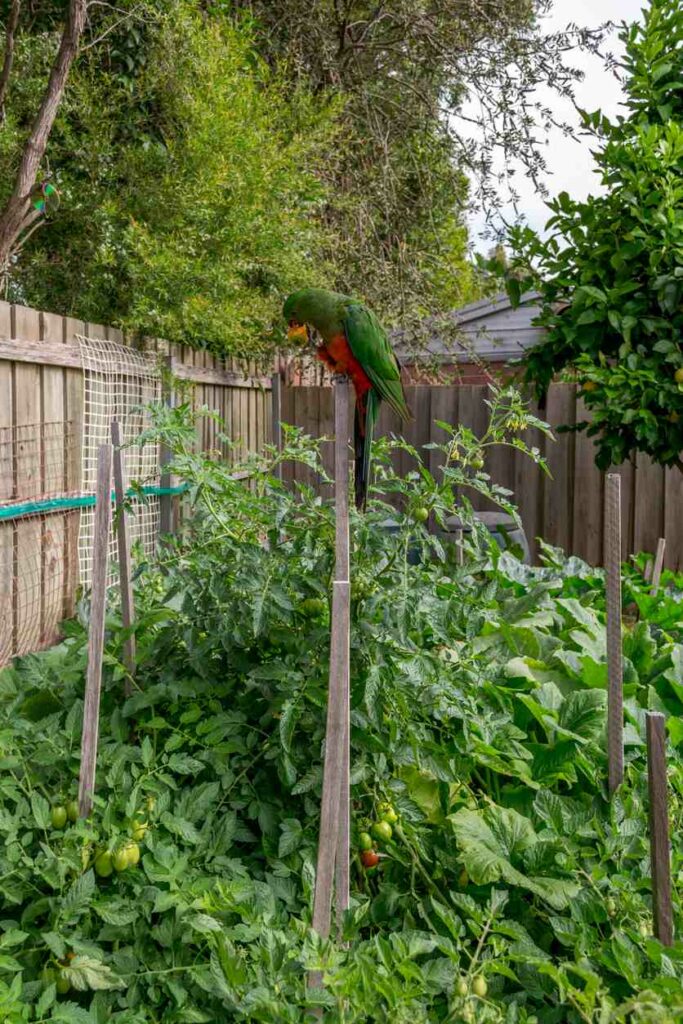Birds Eating Tomato Plants – How To Protect Your Tomato Plants From Birds
One of the most persistent problems facing gardeners is birds eating tomato plants. It doesn’t matter how big or small your tomato patch is. Once the tomatoes turn from green to red, birds swoop in and feast on the ripe crop with greed and abandon. It is both frustrating and demoralizing to see all your hard work growing tomatoes go up in smoke. And knowing the wily birds, it’s not always easy to harvest your tomatoes before they take the lion’s share of your harvest.
It’s true that tomatoes are good in your kitchen for everything from salads to a variety of delicious summer dishes. Which is all the more reason you should protect your tomatoes from the ruthless attacks of birds. So how would you go about doing that? Read on to find out the different ways you can keep birds off your tomato plants.
Bird Damage to Tomato Plants
Before we get to the part where you resort to smart tactics to scare off birds or steer them away from your tomato patch, let’s examine the damage birds often inflict on tomato plants and how it’s different from other tomato predators. When birds such as pigeons attack a ripe tomato, they use their slim beaks to break the skin and get to the fleshy parts of the fruit.
This is usually different from how a rat or a squirrel will feast on the crop. Animals would chew at the skin and leave teeth marks behind. Determining the culprit will help you take the best course of action to protect the crop. The methods you’ll use to deter rabbits or rats from eating your tomato plants are different from those designed for birds.
Moreover, some birds, such as pigeons, will not only eat your ripe tomatoes, they’ll also break down the stems and vines of the tomato to use the pieces in building their nests. Talk about a destructive behavior of epic proportions.
If you see only tiny holes in the skin of the ripe tomato, then you know that birds are targeting your tomatoes and won’t rest until they’ve damaged the last one. So what can you do about it?
How to Protect your Tomato Plants from Birds
Have you ever asked yourself, why birds would go after your tomato plants? It’s not a personal vendetta and birds of all varieties have nothing against you or your garden. They are just hungry and when they see food, they just go for it. Birds and wildlife, in general, have no respect for personal property. So how will that information help you fend off your tomato patch?
It’s simple. If the birds are hungry, then if you gave them food, most likely they’ll leave your tomatoes alone.
Based on this, we can divide the ways you can protect your tomato plants from birds into the following.
- Distraction Tactics: Offer the birds food and water in a strategic location away from the veggie garden as a way of distraction.
- Scare Measures: Birds are easily spooked by anything that looks unfamiliar or out of place. Keep them off your garden and they won’t bother the tomato plants.
- Mechanical Methods: Make it hard for the birds to access or get to the tomato plants by installing barriers such as cages or netting.
The method or combination of tactics you resort to depends on the severity of the damage to your crop and how persistent the birds are in their attempts to deprive you of your delicious tomatoes. The more aggressive the predators, the more drastic your defensive measures. At the end of the day, you’re not trying to harm the birds. You’re simply protecting your veggie patch.
Physical Barriers around Tomato Plants
Unlike other pests and diseases that prey on tomatoes, birds are a relatively easy predator to fend off. You can use cages, netting, or cloches to keep them off your tomato plants.
Cages
Cages are effective not just against birds, but other predators such as rats, possums, and rabbits. The only problem with cages is that they don’t work with all types of tomatoes. Determinate tomatoes are limited in size and will grow well underneath the cage. But indeterminate tomatoes will crawl out of the cage or worse, the cage would stunt its growth and prevent its flowering.
When you choose a cage to work as a defense mechanism against birds, make sure the spaces between the bars or ribs of the cage are narrow enough not to let the small heads or tiny beaks of the birds inside. At the same time, the cage should allow air circulation and sunlight and not cast a large shadow on the plants.
Netting
You can use a netting either in combination with a cage or on its own. Drape a suitable netting over a large cage to keep birds away without depriving the tomato plants of the sun and fresh air. However, sometimes, nettings can be a more effective physical barrier especially if you’re growing indeterminate tomato varieties.
A netting is flexible enough to wrap around a whole tomato plant without posing any risk on the plant’s growth or interfering with the flowering or fruit productivity. But while this method might keep some birds from your ripe tomatoes, it might not be effective against pigeons seeking to turn your tomato plants into a heap of dried nest-building blocks.
Experts recommend that you use nettings along with other support. That way the netting will not come in contact with the tomato plant or allow birds to come within striking distance of the coveted red globes.
Cloches
Cloches are more versatile and effective than nets. A cloche is a cover that protects young plants against cold weather or pests. Most often you’d use a cloche with a sapling to keep the soil warm until the weather improves. But you can also repurpose cloches to serve as a barrier between birds and tomato plants.
- Wire Cloches: You can make a wire cloche from a rabbit wire. It usually has two pieces. The first forms a cylinder shape around the plant while the second piece covers the top of the cylinder. You can adjust the cloche to accommodate the growth of the tomato plant and prevent predators from getting to the tomatoes.
- Plastic Bottle Cloches: More commonly used to protect seeds and saplings against the cold weather and predators, a plastic bottle cloche allows the sunlight in but doesn’t do the same for the air. As a result, you should only use plastic cloches sparingly and avoid using them in hot zones. Once the plant outgrows the cloche, you’ll have to remove it.
Distracting Birds
If physical barriers are not getting the job done and birds still find a way to get to the tomato plants, then you might have to distract them with a bribe. The bribe here is either food or water, or both.
Water
Most of the time, birds will nosh on your ripe tomatoes because they’re thirsty. This is often the case in the hot summer months where water is scarce. Place a bowl full of water in a prominent place for the birds to see. Make sure the water bowl is as far away as you can from the tomato patch.
Keep filling the bowl with water and soon the birds will stop visiting your tomato garden to sample the ripe fruits.
Food
Ripe tomatoes not only quench the birds’ thirst but also offer a tasty and nutritious meal. So lure the hungry birds away from your tomatoes with a bird feeder. Again, you should make the bird feeder visible and easy to access for the birds. Replenish it with sunflower seeds to keep the birds off the tomato plants.
The only drawback to this tactic is that the bird feeder might draw more birds to your garden than you hoped for. But it’s a small price to pay in order to keep your tomato plants safe.
Scare Tactics
Sometimes none of the above strategies will work against the hungry birds. Neither physical barriers nor distractions will sway the persistent birds. In that case, you’ll have to go on the offensive and do your best to keep the birds from your garden.
Scarecrows
A tried and test method that has been used for thousands of years in fields and farms the world over. The idea is to fool the birds into thinking a human is standing guard in the garden at all times. You can use a pair of sticks to make the body in the shape of a cross. Then dress up your stick man convincingly. Fill a bag with cotton or rags, draw a face on it and stick it at the top. Use an old shirt and trousers to complete the disguise. And don’t forget about the hat.
Hanging Objects
When all else fails, you can still resort to flashy objects and wind chimes to spook the birds. You could use more than one device for dramatic effects. Most often the birds won’t stop to have another look.
- Wind Chimes: While not scary on their own, the unexpected presence of a wind chime that makes a weird sound in the garden will deter the birds from going near the tomato plants. Place a few wind chimes in strategic spots around the veggie patch for best results.
- Flashy Objects: To create the desired visual effect that goes with the wind chimes, tie a few CDs to a stick and let them sway freely in the wind. Whenever the CDs catch the sun, they will flash out warnings to any intruders on the wing.
- Reflectors: If you have an old bike or some used vehicle reflectors lying around, why not hang them in the garden to scare away the birds? Keep in mind, that moving reflectors are more effective than fixed ones. So tie them to a string and dangle it from the roof. No bird will come near your garden again.

